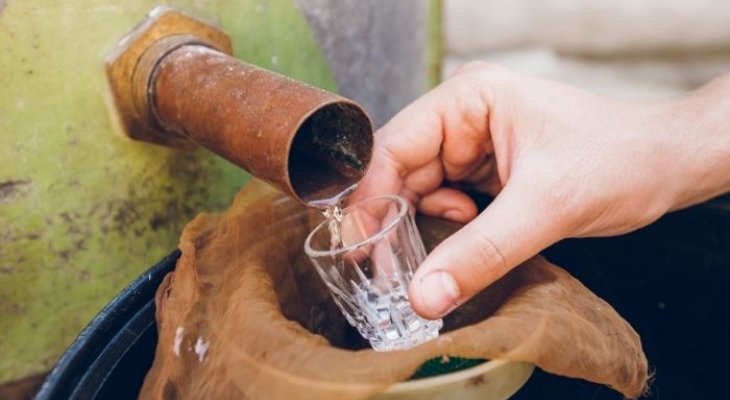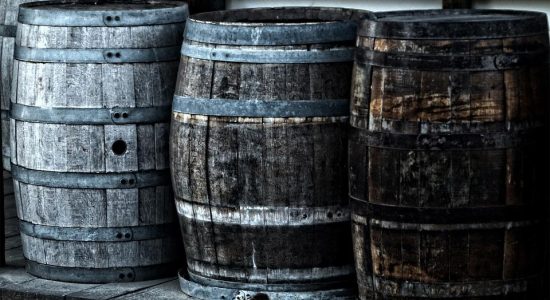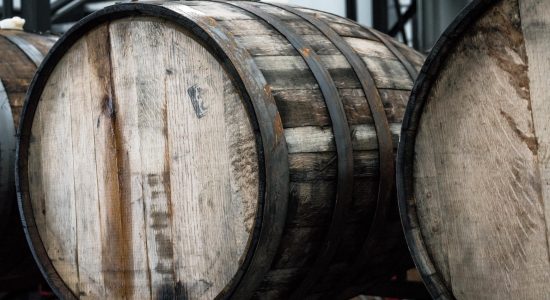Complete Guide on How to Make Moonshine: Step by Step Recipe

If you’ve ever tried a swig of real moonshine, you already know how powerful it can be.
Perhaps you want to make your own but aren’t quite sure how it’s done. Keep in mind that distilling moonshine is illegal in all 50 states and is never encouraged. Still, if you’re curious about the process of distilling moonshine, you’ve come to the right place.
Not sure how to make moonshine? Generally speaking, moonshine is made through the fermentation and distillation processes, by which the sugars that make up the base ingredients (popularly called “mash”) of moonshine into alcohol and then are distilled through the boiling process into high-proof spirits.
Simplified steps on how to make Moonshine:
- Heat the water
- Add malted barley
- Strain and aerate the mash
- Add the yeast
- Prep the still
- Add the mash to the still
- Heat the still
- Collect the distillate in glass containers
Coming up, we’ll explore all the steps above in detail. If you are here to learn the process of making moonshine, keep reading to find out how it’s done!
Read Also: What is Moonshine Really Made Of?
Equipment Needed to Make Moonshine
You’ll need more than your bathtub to make a real batch of moonshine.
Having the right equipment ensures not only the taste and quality of your shine, but it also helps you stay safe throughout the creation process. For this reason, you’ll want to make sure that you’ve got all the equipment you’ll need before you embark on your moonshining adventure.
With that being said, let’s take a brief look at some of the equipment you’ll need to make your first (or next) batch of moonshine.
Fermentation Vessel
Before the moonshiner can distill his/her alcohol, he/she must first go through the fermentation process.
The only way to do this is with a fermentation vessel, which is typically done using carboys (Amazon link), which are glass demijohns, though fermentation vessels can also be made out of plastic. The important point here is to use something that can withstand heat.
TIP: The mash will be kept in this vessel throughout the fermentation process, so you’ll want to use material that doesn’t melt or warp.
Airlock
The fermentation process also requires the use of an airlock (Amazon link), a plastic piece that’s attached to the fermentation vessel to enable the release of carbon dioxide.
The airlock prevents the introduction of oxygen into the mash, which keeps the substance fresh.
Pot (or Still)
There are two main ways of creating moonshine: with a pot (the traditional way) or with a reflux still (Amazon link) (the more efficient, yet more expensive way).
Generally speaking, pot stills are the way to go for simple moonshining, as they require only that you boil the mash inside them. The alcohol will evaporate and travel into a coil (called the worm) that’s laid in cold water. From there, it will condense back into liquid form, giving you a flavorful alcohol.
Reflux columns work more efficiently, using built-in columns to distill the alcohol to higher levels of purity.
While this creates a proof higher than 80%, it also removes much of the flavor from the alcohol.
Electricity
You can’t distill alcohol without heat. While moonshine has traditionally been produced with open flames, electrical heating methods make the process exponentially safer. Smaller stills can be produced well on electric stoves (Amazon link) and hot plates.
Thermometer
It’s always helpful to have a thermometer (Amazon link) on hand to test the temperature of your liquids. This tool will allow you to keep track of the distillation process, whether you’re using a pot or reflux still (though they may not be necessary for more advanced moonshiners).
Hydrometer
You’ll also need a hydrometer (Amazon link) if you plan on checking the ABV (alcohol by volume) of your shine.
These tools work to measure ABV by sinking more deeply into the liquid the higher proof it is. A hydrometer can also tell you how much sugar is in your alcohol by testing the stage of fermentation.
Read Also: Best Books on How to Make Moonshine
Ingredients Needed to Make Moonshine (Traditional Corn Mash Recipe)
Simple enough, right?
If you feel you’ve got this information mastered, it’s time to look at some of the common ingredients used for making moonshine. It’s important to keep in mind that the ingredients for moonshine depending on who’s making it and what the desired flavor is.
In this section, we’ll take a look at a traditional corn mash recipe that’s simple to make and flavorful to boot:
Corn Maize
This will be the main ingredient of your mash. Corn maize (Amazon link) offers a strong flavor and can be used to produce high-proof alcohols.
Yeast
Yeast (Amazon link) helps boost the alcohol content of your spirit.
Malted Barley
When added to the corn maize, crushed malted barley (Amazon link) helps improve flavor and alcohol density by turning the ingredients into sugars that can later be transformed into alcohol.
Dark molasses and malt syrup can also be added to provide a deeper balance of flavors for the final spirit.
Water
Before fermentation begin, the mash (the combination of ingredients listed above) must be boiled at high temperatures. To do this, you’ll need gallons of water at the ready.
Make Moonshine with a Still in 8 Steps
Using the ingredients above, let’s take a look at how you could make a simple moonshine recipe in eight easy steps:
#1 Heat Your Water
Pour between 5-6.5 gallons of water into your pot and boil it. Use a thermometer to test the temperature of the water, continuing the process until the liquid is at least 165 degrees Fahrenheit. Turn off the heat once you’ve reached the desired temperature and pour in your corn maize.
Take care to stir the maize continuously for 3-5 minutes. Following this, stir once every 5-10 seconds for an additional five minutes.
NOTE: During this process, the maize should noticeably thicken.
Read Also: Best Propane Burners for Brewing
#2 Add Malted Barley
Keeping an eye on the temperature, add the malted barley once your mixture reaches around 150 degrees Fahrenheit. Stir continuously for two minutes. Once done, let the mash sit for an hour and a half with a lid covering it.
#3 Strain and Aerate the Mash
Once the mash has cooled to about 70 degrees Fahrenheit, pour your mash through a cheesecloth to separate the liquids from the solids.
Then, you’ll want to pour the mash liquid back and forth approximately fifteen times between two sanitized buckets.
You should notice frothing during this process, a sign that the fermentation process was effective.
You can gain a good indicator of the alcohol content of the mash by using a hydrometer at this point.
#4 Add the Yeast
Once you’ve taken the hydrometer reading, it’s time to add the yeast. At this point, your mash should be in a fermentation vessel, to which you’ll also add your yeast before sealing with an airlock. This yeast will start the fermentation process, which could last as long as three weeks.
REMEMBER: Do not attempt to distill your alcohol if it’s still bubbling, as fermentation is still ongoing.
#5 Prep Your Still
You’ll want to make sure your still is clean before you attempt to distill your mash. Give it a good clean, making sure to pack the column of your reflux still at this point.
#6 Add the Mash to the Still
Once your still is clean, it’s time to add the mash.
One easy way to do this is with a cheesecloth, which can remove further imperfections from the mash.
#7 Heat Your Still
In order to separate the fermented alcohol from the other substances in your mixture, you’ll need to reach pretty high temperatures. Aim for about 150 degrees Fahrenheit.
Once your still has reached this temperature, make sure to turn the condensing water on in your still.
This step is important in creating the distillate that you will eventually collect as spirits.
After you’ve done this, you want to increase the temperature until you’re getting around 5 drips per second in the condenser (after which you’ll likely need to lower the temperature again to maintain this rate).
#8 Collect Your Distillate in Glass Containers
Always collect your distillate in glass, as the heat of the moonshine can combine with chemicals in plastics and other substances to create a harmful liquid.
IMPORTANT: Make sure to discard the first 35% (foreshots and heads) of your shine, as well, which can contain harmful gasses that can even prove fatal (more on that later).
For the next step, you will be collecting the “hearts” of your moonshine. This percentage of your shine will smell and taste sweeter. Also, because it is ethanol-based, it won’t be deadly, even if it’s high-proof.
The latter part of your distillate, known as “tails,” will often be oily and generally needs to be distilled again in order to obtain purity. Really, then, what you’re aiming for is collecting the middle 30% of your distillate for a finished product that is smooth and flavorful.
Read Also: How to Proof Moonshine in 4 Easy Steps
3 Things You Need to Know before Making Moonshine at Home
With all this being said, there are some things you’ll want to—hypothetically—know before making your own moonshine at home.
Keep in mind that the production of moonshine is dangerous for a variety of reasons (as detailed below), so you’ll want to pay close attention to the following if moonshining is your hypothetical goal:
#1 It’s Illegal
The distillation and selling of moonshine are illegal across the United States. These actions are punishable by federal law, so you should never distill moonshine unless you have a permit.
#2 Clean Your Still Beforehand
Because leaky alcohol vapor can be deadly, it’s crucial that you identify any potential leaks before you distill any alcohol. This can be done by running water through the still prior to the distillation process. This water will help remove impurities from the still, as well as show you where leaks are.
Read more on this in this article here.
#3 Don’t Drink the Foreshots
Have you heard the wives’ tales of men going blind from moonshining? They’re true. That’s because moonshine contains two different gasses: methanol and ethanol. While having ethanol is important for your alcohol content, methanol is deadly.
Fortunately, with its low boiling point, methanol can be burned off moonshine relatively quickly. Still, you don’t want to drink the initial batch (first 5%) of moonshine, called foreshots, that likely have this methanol in them.
TIP: For safest results, it’s always best to distill the liquid multiple times to ensure that all methanol has been removed.
Importantly, you can often identify methanol by its strong solvent-like smell.
How Long Does It Take to Make Moonshine?
As you can see, the process of fermenting and distilling moonshine is quite time-consuming. In general, you can expect it to take between 1-3 weeks to make moonshine, as the mash must ferment and the distillation process must be continued until the final shine is safe for consumption.
Final Thoughts
If you’re looking, hypothetically of course, to make your first batch of moonshine, you’ve got your work cut out for you.
The process requires multiple steps and can be broken down into two main stages: fermenting the mash and distilling the alcohol.
With the information in this guide, you can begin to gain a better understanding of how moonshine is made. Make sure to use this piece to answer any questions you may have about the process of creating moonshine!







